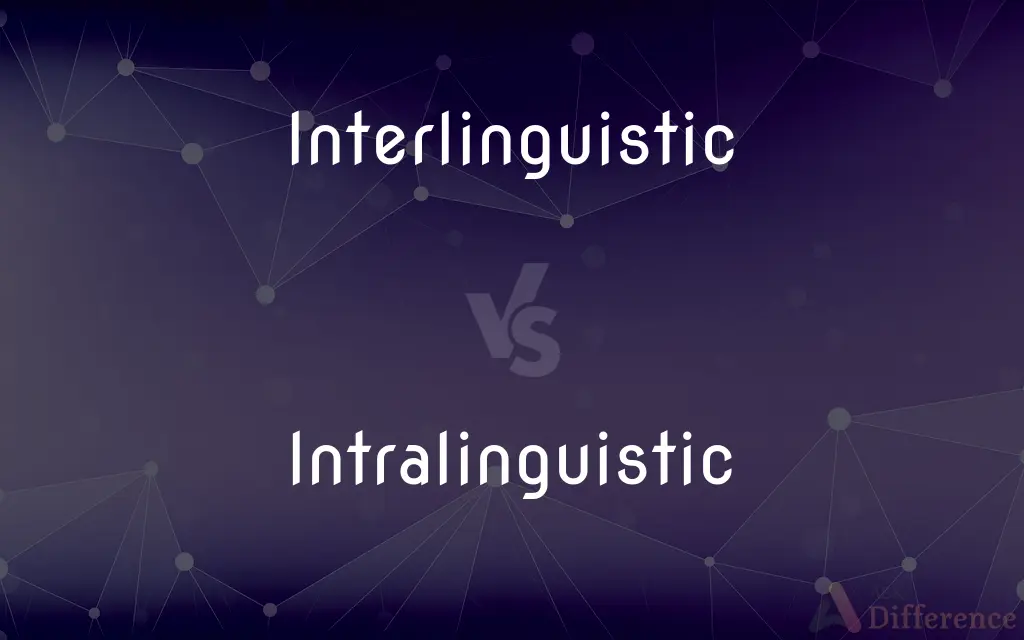Interlinguistic vs. Intralinguistic — What's the Difference?
Edited by Tayyaba Rehman — By Urooj Arif — Updated on March 29, 2024
Interlinguistic refers to phenomena between different languages, while intralinguistic pertains to elements within the same language.

Difference Between Interlinguistic and Intralinguistic
Table of Contents
ADVERTISEMENT
Key Differences
Interlinguistic analysis or comparison deals with the relationships and differences between two or more languages. On the other hand, intralinguistic aspects focus on phenomena occurring within a single language.
While interlinguistic studies are crucial for understanding the dynamics between languages, especially in multilingual societies or for translation purposes, intralinguistic studies are essential for a deep understanding of the structure and function of a language. Both perspectives are vital in linguistics but address different levels of language analysis.
Interlinguistic research often supports language learning and translation by highlighting the comparative aspects and intersections between languages, which can reveal common roots or shared structures. Conversely, intralinguistic research can enhance language teaching by providing insights into the complexities and nuances of a language, making it easier to explain grammar rules or usage patterns to learners.
The distinction between interlinguistic and intralinguistic is not just academic; it has practical implications in language teaching, translation, and linguistics research. While interlinguistic knowledge can help bridge gaps between languages, intralinguistic knowledge is crucial for mastering the subtleties and depth of a single language.
Comparison Chart
Definition
Pertaining to phenomena between different languages.
Pertaining to elements within the same language.
ADVERTISEMENT
Focus
Comparison and influence between languages.
Analysis of a language's structure and functions.
Applications
Language learning, translation, multilingual studies.
Language teaching, grammar, syntax analysis.
Examples
Studying loanwords from French in English.
Analyzing the use of verb tenses in English.
Importance
Enhances understanding of linguistic diversity and translation challenges.
Essential for deep comprehension of a language's intricacies.
Compare with Definitions
Interlinguistic
Linguistic Influence.
English's influence on global languages is an interlinguistic phenomenon.
Intralinguistic
Syntax Analysis.
Intralinguistic studies examine how sentence structures vary within English dialects.
Interlinguistic
Language Comparison.
Comparing grammatical structures between German and English reveals interlinguistic differences.
Intralinguistic
Morphology.
The formation of plural nouns in English involves intralinguistic rules.
Interlinguistic
Translation Studies.
Interlinguistic analysis is crucial for effective translation, especially of idiomatic expressions.
Intralinguistic
Semantics.
Intralinguistic research into semantics explores word meanings and their usage in context.
Interlinguistic
Loanwords.
The study of loanwords is an interlinguistic exploration of how languages borrow from each other.
Intralinguistic
Phonetics and Phonology.
Analyzing the sounds of a language is an intralinguistic approach to understanding its phonetic system.
Interlinguistic
Multilingualism.
Multilingual speakers navigate interlinguistic spaces by switching between languages.
Intralinguistic
Language Teaching.
Effective language teaching requires deep intralinguistic knowledge to explain grammar and usage.
Interlinguistic
Of or pertaining to interlinguistics.
Intralinguistic
Within a single language; contrasted with cross-linguistic.
Interlinguistic
Between languages.
Intralinguistic
Linguistic, language-only; due to linguistic factors and processes; contrasted with extra-linguistic.
Intralinguistic
Within a particular language;
Intralinguistic variation
Common Curiosities
What role does intralinguistic analysis play in language teaching?
Intralinguistic analysis is fundamental in language teaching, as it helps educators explain the rules, patterns, and exceptions of a language to learners.
How do interlinguistic studies contribute to language learning?
Interlinguistic studies can aid language learning by highlighting similarities and differences between languages, facilitating easier acquisition of a second language through comparative methods.
Why are intralinguistic studies important for linguists?
Intralinguistic studies are crucial for understanding the structure, function, and evolution of a language, providing insights into syntax, semantics, and phonology.
Can someone specialize in both interlinguistic and intralinguistic linguistics?
Yes, many linguists have expertise in both areas, as understanding both the comparative and detailed aspects of languages enriches their overall linguistic knowledge and research capabilities.
Do interlinguistic studies only focus on languages from different families?
Not necessarily; interlinguistic studies can examine languages from the same family to understand their divergence and convergence over time, as well as languages from different families.
How does multilingualism relate to interlinguistic studies?
Multilingualism is directly related to interlinguistic studies as it involves navigating, understanding, and comparing multiple languages, enriching our understanding of linguistic diversity and interaction.
Are loanwords considered an interlinguistic or intralinguistic phenomenon?
Loanwords are considered an interlinguistic phenomenon because they involve the adoption and adaptation of words from one language into another.
Can interlinguistic knowledge improve translation accuracy?
Yes, understanding the nuances and structures of both the source and target languages can significantly enhance the accuracy and quality of translations.
What is a practical application of intralinguistic knowledge outside of academia?
Intralinguistic knowledge is invaluable in language therapy and speech pathology, where understanding the nuances of a language can aid in diagnosing and treating language-related disorders.
What is the main difference between interlinguistic and intralinguistic?
The main difference lies in the focus; interlinguistic pertains to phenomena between different languages, while intralinguistic focuses on elements within the same language.
What challenges do translators face from an interlinguistic perspective?
Translators often face challenges related to idiomatic expressions, cultural references, and syntactical differences that require not just linguistic, but also cultural and contextual understanding.
Can intralinguistic variations lead to misunderstandings within the same language?
Yes, intralinguistic variations, such as dialects or sociolects, can lead to misunderstandings or miscommunications among speakers of the same language.
How does an intralinguistic approach help in the preservation of languages?
An intralinguistic approach can aid in the preservation of languages by documenting and analyzing their unique features, structures, and usage, contributing to linguistic diversity and heritage.
How do interlinguistic factors affect global communication?
Interlinguistic factors, such as language borrowing and the development of pidgins and creoles, play a significant role in global communication by facilitating understanding and interaction between speakers of different languages.
Share Your Discovery

Previous Comparison
Injector vs. Injecter
Next Comparison
Thyme vs. ZaatarAuthor Spotlight
Written by
Urooj ArifUrooj is a skilled content writer at Ask Difference, known for her exceptional ability to simplify complex topics into engaging and informative content. With a passion for research and a flair for clear, concise writing, she consistently delivers articles that resonate with our diverse audience.
Edited by
Tayyaba RehmanTayyaba Rehman is a distinguished writer, currently serving as a primary contributor to askdifference.com. As a researcher in semantics and etymology, Tayyaba's passion for the complexity of languages and their distinctions has found a perfect home on the platform. Tayyaba delves into the intricacies of language, distinguishing between commonly confused words and phrases, thereby providing clarity for readers worldwide.















































